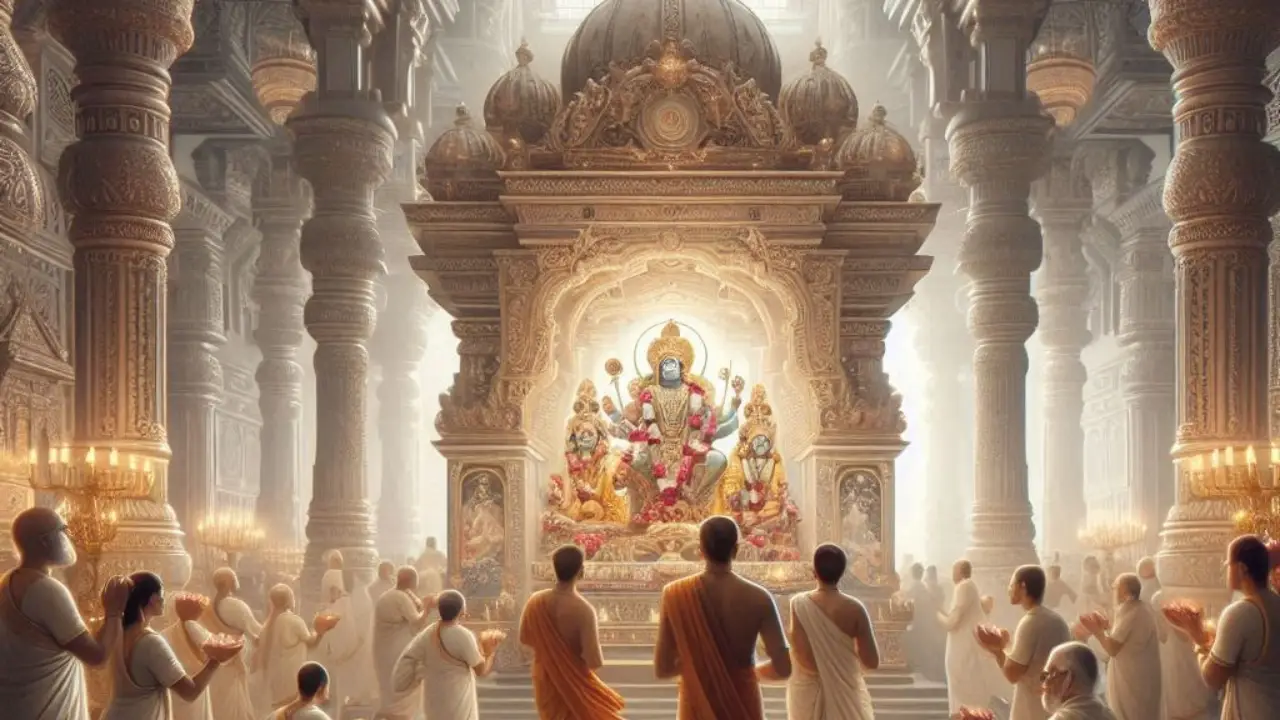Imagine entering a Hindu temple, the air rich with the scent of incense and the soft murmur of prayers. One of the profound practices you’ll witness here is the act of circumambulating the sanctum, or “pradakshina.” This ritual, where devotees walk clockwise around the sacred center, is deeply imbued with spiritual meaning and significance.
Understanding Pradakshina
Pradakshina is derived from two Sanskrit words: “pra,” meaning “before,” and “dakshina,” meaning “to the right.” The practice involves moving in a circular path, always keeping the sanctum to the right. This motion is not arbitrary; it symbolizes reverence and the belief that the divine energy radiates outward from the center.
The circular path itself holds cosmic significance. In Hinduism, the circle represents completeness and eternity. Walking in a circle around the deity symbolizes the cyclical nature of life and the universe, acknowledging the infinite and interconnected nature of all existence.
Symbolism and Spiritual Benefits
Circumambulating the temple sanctum is seen as a journey of devotion and humility. Each step taken is an offering of one’s ego to the divine, a physical manifestation of surrender and devotion. The act of walking in a circle also symbolizes the removal of obstacles and the purification of the mind and soul.
Many believe that this ritual helps in aligning oneself with cosmic energies. As the devotee walks, the sanctum’s spiritual energy is said to envelop them, creating a harmonious flow of energy. This practice is thought to aid in achieving mental peace, spiritual clarity, and a deeper connection with the divine.
Historical and Scriptural References
The practice of pradakshina has ancient roots. References can be found in various Hindu scriptures like the Vedas and Puranas, which emphasize the importance of circumambulation. The Skanda Purana, for instance, narrates that Lord Shiva himself advised the sages to perform pradakshina as a way to attain spiritual merit.
In the Mahabharata, there’s a story of Arjuna circumambulating Lord Krishna, acknowledging his divine presence. Such stories reinforce the significance of this ritual in the Hindu tradition, underscoring its role in expressing devotion and seeking divine blessings.
Pradakshina in Different Temples
While the core practice remains the same, the execution of pradakshina varies slightly across different temples and regions. In the famous Jagannath Temple in Puri, devotees perform pradakshina around the temple complex rather than just the sanctum, symbolizing a more expansive reverence.
In the temples of South India, particularly those dedicated to Lord Vishnu and Lord Shiva, the number of circumambulations often has specific significance. Devotees might perform one, three, five, or even seven circumambulations, each number holding unique spiritual meanings. For instance, three circumambulations often symbolize the three fundamental aspects of existence: creation, preservation, and destruction.
Personal Stories and Experiences
For many, the practice of pradakshina is a deeply personal and transformative experience. Take the story of Meera, a devotee from Chennai, who shared how her regular circumambulation around the sanctum of Kapaleeshwarar Temple brought her immense peace and clarity during a turbulent phase of her life. She described the act as not just a ritual but a meditative process that helped her connect with her inner self and the divine.
Another devotee, Ramesh, recounted his experience at the Tirupati Balaji Temple. Despite the crowd and the chaos, the act of pradakshina provided him with a sense of calm and grounding. It was his way of expressing gratitude and seeking blessings, a moment of spiritual intimacy amidst the throngs of worshippers.
Practical Tips for Performing Pradakshina
For those new to this practice, here are a few tips to enhance your pradakshina experience:
Maintain a Reverent Mindset: Approach pradakshina with a sense of devotion and humility. It’s not just about the physical act but the intention behind it.
Focus on the Deity: Keep your focus on the deity as you walk. This helps in maintaining a spiritual connection and reinforces the purpose of the ritual.
Chant or Meditate: Recite mantras or engage in silent meditation during pradakshina. This enhances the spiritual experience and keeps the mind centered.
Be Mindful of Pace: Walk at a comfortable, reverent pace. Rushing through the ritual can detract from its spiritual benefits.
Respect Temple Etiquette: Follow the temple’s specific customs and guidelines regarding pradakshina. This shows respect for the tradition and the sanctity of the space.
The Deeper Connection
The act of circumambulating the temple sanctum is more than a ritual; it’s a journey towards inner peace and spiritual enlightenment. It represents the devotee’s dedication, humility, and desire to connect with the divine presence. As the body moves in a sacred circle, the mind and spirit align with the eternal, embracing the divine energy that flows through the universe.
Whether you are a devout Hindu or a curious observer, witnessing or participating in pradakshina offers a glimpse into the rich tapestry of Hindu spirituality. It’s a reminder of the timeless traditions that continue to inspire and uplift countless devotees, guiding them on their spiritual journeys.
Have you ever experienced the practice of pradakshina? Share your thoughts and stories in the comments below. Let’s explore the spiritual significance of this ancient ritual together.

